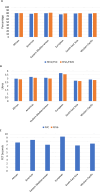Concordance between FVC and FEV6 for identifying chronic airflow obstruction and spirometric restriction in the Burden of Obstructive Lung Disease (BOLD) study
- PMID: 40659415
- PMCID: PMC12258291
- DOI: 10.1136/bmjresp-2024-002355
Concordance between FVC and FEV6 for identifying chronic airflow obstruction and spirometric restriction in the Burden of Obstructive Lung Disease (BOLD) study
Abstract
Introduction: We investigated whether the forced expiratory volume in 6 s (FEV6) can be used as a surrogate for the forced vital capacity (FVC).
Methods: The Burden of Obstructive Lung Disease is a multinational cohort study. At baseline, data were collected from adults, aged 40 years or older, from 41 sites across 34 countries. Participants from 18 sites were followed-up after a median of 8.3 years. Participants who completed the study core questionnaire and had acceptable post-bronchodilator spirometry were included. We performed receiver operating characteristic analyses to measure the ability of FEV1/FEV6 less than the lower limit of normal (LLN) to correctly classify FEV1/FVC less than the LLN, and FEV6 less than the LLN to correctly classify FVC less than the LLN. We used multilevel regression analyses to assess the association of discordant measurements with respiratory symptoms, quality of life and lung function decline.
Results: At baseline, 28 604 participants were included. 53% were female (15 060). 10% (2876) had chronic airflow obstruction for FEV1/FVC, compared with 9% (2704) for FEV1/FEV6. 37% (10 637) had spirometric restriction for FVC, compared with 35% (9978) for FEV6. The FEV1/FEV6 had excellent accuracy in identifying FEV1/FVC less than the LLN (area under the curve (AUC): 0.90, 95% CI, 0.89 to 0.91, κ coefficient 0.82). The FEV6 also had excellent agreement in identifying FVC less than the LLN (AUC: 0.95, 95% CI, 0.94 to 0.95, κ coefficient 0.90). Discordant reductions in FEV1/FEV6 (1%, 345) and FEV6 (1%, 309) were associated with greater odds of having respiratory symptoms and a lower physical quality of life. 3870 participants were followed up. Those with discordant reductions in FEV1/FEV6 and FEV6 were more likely to have chronic airflow obstruction and spirometric restriction at follow-up.
Conclusions: There is strong agreement between the FVC and FEV6 in the identification of chronic airflow obstruction and spirometric restriction.
Keywords: Clinical Epidemiology; Lung Physiology; Respiratory Function Test; Respiratory Measurement; Sensitivity and Specificity.
© Author(s) (or their employer(s)) 2025. Re-use permitted under CC BY. Published by BMJ Group.
Conflict of interest statement
Competing interests: The baseline study was funded in part by a grant from the Wellcome Trust (085790/Z/08/Z), which supported the coordinating centre in London, UK, and in part by unrestricted educational grants from University of Kentucky, Aventis, AstraZeneca, Boehringer-Ingelheim, Chiesi, GlaxoSmithKline, Merck, Novartis, Pfizer, Schering-Plough and Sepracor. The follow-up study in LMICs was funded by the UK Medical Research Council (MR/R011192/1) and in European countries by AstraZeneca AB (ESR-17-13417). FMEF reports grants and personal fees from AstraZeneca, grants and personal fees from Chiesi, grants and personal fees from GlaxoSmithKline, personal fees from Pieris, grants and personal fees from Sanofi, outside the submitted work. FR reports grants and personal fees from A. Menarini, Boehringer Ingelheim, Teva Pharma, Novartis, GlaxoSmithKline, AstraZeneca, VitalAire and Nippon Gases outside the submitted work. DM is a consultant to AstraZeneca, GlaxoSmithKline, Regeneron, Genentech, outside of the submitted work, and serves as an expert witness on behalf of people suing the tobacco and vaping industries. All other authors declare no competing interests.
Figures


References
Publication types
MeSH terms
LinkOut - more resources
Full Text Sources
Medical
